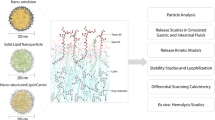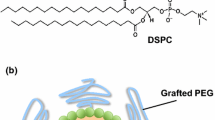Abstract
Tin mesoporphyrin (SnMP) is a competitive inhibitor of heme oxygenase being examined clinically for the treatment of hyperbilirubinemia. Since liposomes have been shown to target SnMP to the spleen and increase its efficacy (S. A. Landaw, G. S. Drummond, and A. Kappas, Pediatrics 84, 1091–1096, 1989), we began investigating the feasibility of the preparation and scaleup of a liposomal SnMP formulation for clinical use. SnMP liposomes were prepared by high-pressure homogenization of a suspension of SnMP and egg phosphatidylcholine (1:20, w/w) in lactose-phosphate buffer, resulting in SnMP liposomes that were less than 200 nm in diameter and had encapsulation efficiencies of up to 90% at pH 5. The SnMP liposomes could be sterile filtered and lyophilized in a 1-day cycle with retention of the encapsulation efficiency and particle size. Following injection into rats, the distribution of liposomal SnMP to spleen at 2 and 6 hr after dosing was 5–20 times higher than for aqueous SnMP. Lyophilized SnMP liposomes were also more effective than aqueous SnMP in decreasing bilirubin production in bile-cannulated rats. The results suggest the potential for producing a safe, sterile, and effective lyophilized formulation of SnMP liposomes for targeting of heme oxygenase inhibitors to the spleen.
Similar content being viewed by others
REFERENCES
G. S. Drummond and A. Kappas. Prevention of neonatal hyperbilirubinemia by tin protoporphyrin IX, a potent competitive inhibitor of heme oxidation. Proc. Natl. Acad. Sci. USA 78:6466–6470 (1981).
A. Kappas, G. S. Drummond, C. S. Simionatto, and K. E. Anderson. Control of heme oxygenase and plasma levels of bilirubin by a synthetic heme analogue, tin-protoporphyrin. Hepatology 4:336–341 (1984).
A. Kappas and G. S. Drummond. Control of heme metabolism with synthetic metalloporphyrins. J. Clin. Invest. 77:335–339 (1986).
A. Kappas, G. S. Drummond, T. Manola, S. Petmezaki, and T. Valaes. Sn-Protoporphyrin use in the management of hyperbilirubinemia in term newborns with direct Coombs-positive ABO incompatibility. Pediatrics 81:485–497 (1988).
W. R. Porter and K. Brandt. Kinetics of decomposition of tin protoporphyrin in aqueous solution at neutral pH (Abstract No. G04-X-05). J. Pharm. Sci. 76(11):S146 (1987). (b) W. R. Porter and K. Brandt. Chemistry of tin protoporphyrin in aqueous solution (Abstract No. G04-X-06) J. Pharm. Sci. 76(11):S146 (1987).
W. R. Porter, J. Bauer, and B. Norris. Unpublished results.
G. S. Drummond, R. A. Galbraith, M. K. Sardana, and A. Kappas. Reduction of the C2 and C4 vinyl groups of Sn-protoporphyrin to form Sn-mesoporphyrin markedly enhances the ability of the metalloporphyrin to inhibit in vivo heme catabolism. Arch. Biochem. Biophys. 255:64–74 (1987).
S. A. Landaw, G. S. Drummond, and A. Kappas. Targeting of heme oxygenase inhibitors to the spleen markedly enhances their ability to diminish bilirubin production. Pediatrics 84:1091–1096 (1989).
L. Saunders, J. Perrin, and D. B. Gammack. Ultrasonic irradiation of some phospholipid sols. J. Pharm. Pharmacol. 14:567–572 (1962).
A. L. Weiner, J. B. Cannon, and P. Tyle. Commercial approaches to the delivery of macromolecular drugs with liposomes. In M. Rossoff (ed.), Controlled Release of Drugs: Polymers and Aggregate Systems, VCH, New York, 1989, p. 233.
L. D. Mayer, M. J. Hope, and P. R. Cullis. Vesicles of variable sizes produced by a rapid extrusion procedure. Biochim. Biophys. Acta 858:161–168 (1986).
H. G. Weder and O. Zumbuehl. The preparation of variably sized homogenous liposomes for laboratory, clinical, and industrial use by controlled detergent dialysis. In G. Gregoriadis (ed.), Liposome Technology, Vol. I. Preparation of Liposomes, CRC Press, Boca Raton, FL, 1984, pp. 79–107.
E. Mayhew, R. Lazo, W. J. Vail, J. King, and A. M. Green. Characterization of liposomes prepared using a microemulsifier. Biochim. Biophys. Acta 775:169–174 (1984). (b). S. Vemuri, C. Yu, V. Wangsatorntanakun, and N. Roosdorp. Large scale production of liposomes by a microfluidizer. Drug Dev. Ind. Pharm. 16:2243–2256 (1990).
N. I. Payne, P. Timmins, C. V. Ambrose, M. D. Ward, and F. Ridgway. Proliposomes: A novel solution to an old problem. J. Pharm. Sci. 75:325–329 (1986).
M. B. Bally, M. J. Hope, C. J. A. Van Echteld, and P. R. Cullis. Uptake of safranine and other lipophilic cations into vesicles in response to a membrane potential. Biochim. Biophys. Acta 812:66–76 (1985).
D. J. A. Crommelin and E. M. G. Van Bommel. Stability of liposomes on storage: Freeze dried, frozen or as an aqueous dispersion. Pharm. Res. 1:159–163 (1984).
L. M. Crowe, J. H. Crowe, A. Rudolph, C. Womersley, and L. Appel. Preservation of freeze-dried liposomes by trehalose. Arch. Biochem. Biophys. 242:240–247 (1985).
C. Kirby and G. Gregoriadis. Dehydration-rehydration vesicles: A simple method for high yield entrapment in liposomes. Biotechnology 2:979–984 (1984).
J. Bauer, C. Linton, and B. Norris. Stability-indicating high-performance liquid chromatographic analysis of tin protoporphyrin and other free acid metalloporphyrins. J. Chromatogr. 445:429–432 (1988).
J. B. Cannon, F.-S. Kuo, R. F. Pasternack, N. M. Wong, and U. Muller-Eberhard. Kinetics of the interaction of hemin liposomes with heme binding proteins. Biochemistry 23:3715–3721 (1984).
T. M. Allen. Interactions of liposomes and other drug carriers with the mononuclear phagocyte system. In G. Gregoriadis (ed.), Liposomes as Drug Carriers: Recent Trends and Progress, John Wiley & Sons, Chichester UK, 1988, pp. 37–50. (b) J. H. Senior. Fate and behavior of liposomes in vivo: A review of controlling factors. Crit. Rev. Ther. Drug. Carrier Syst. 3:123–193 (1987).
U. Muller-Eberhard and H. Nikkila. Transport of tetrapyrroles by proteins. Semin. Hematol. 26:86–104 (1989).
J. B. Cannon, F.-S. Kuo, F. Vatandoust, H. H. Liem, and U. Muller-Eberhard. The effect of metalloporphyrins and heme liposomes on aminolevulinate synthase activity in rat liver. Biochem. Biophys. Res. Commun. 130:306–312 (1985).
E. Breslow, R. Chandra, and A. Kappas. Biochemical properties of the heme oxygenase inhibitor, Sn-protoporphyrin. J. Biol. Chem. 261:3135–3141 (1986).
G. Jori, E. Reddi, I. Cozzani, and L. Tomio. Controlled targeting of different subcellular sites by porphyrins in tumor-bearing mice. Br. J. Cancer 53:615–621 (1986).
Author information
Authors and Affiliations
Rights and permissions
About this article
Cite this article
Cannon, J.B., Martin, C., Drummond, G.S. et al. Targeted Delivery of a Heme Oxygenase Inhibitor with a Lyophilized Liposomal Tin Mesoporphyrin Formulation. Pharm Res 10, 715–721 (1993). https://doi.org/10.1023/A:1018911816814
Issue Date:
DOI: https://doi.org/10.1023/A:1018911816814




